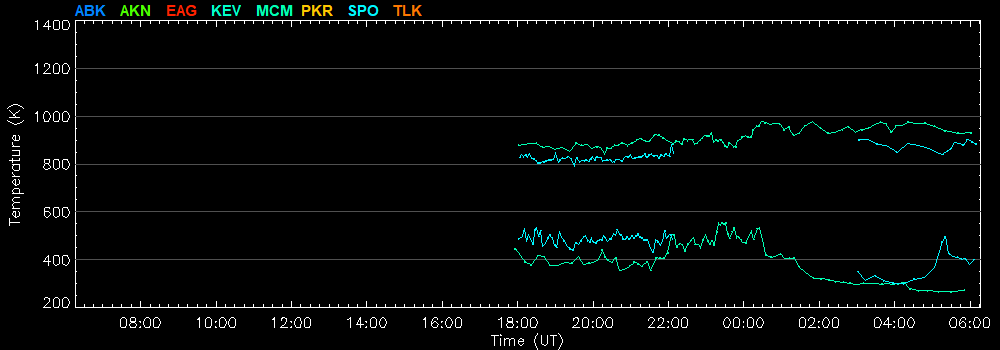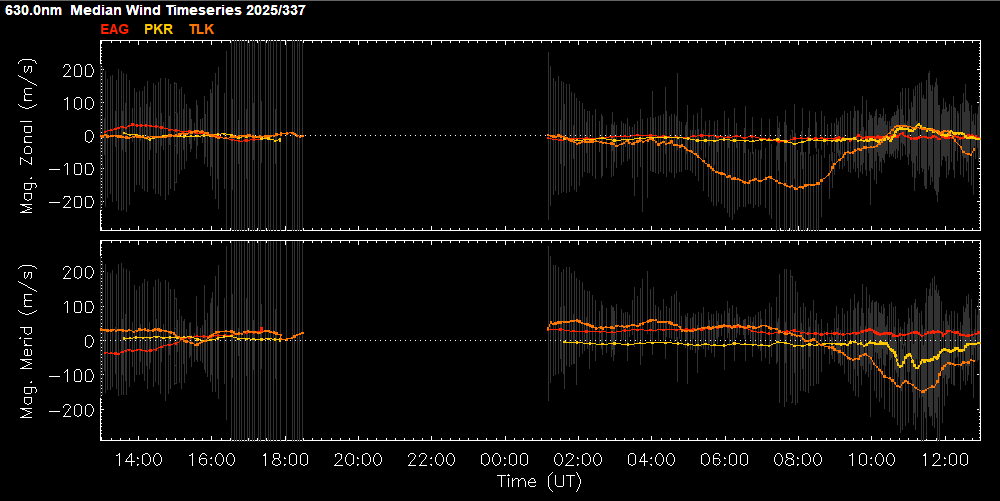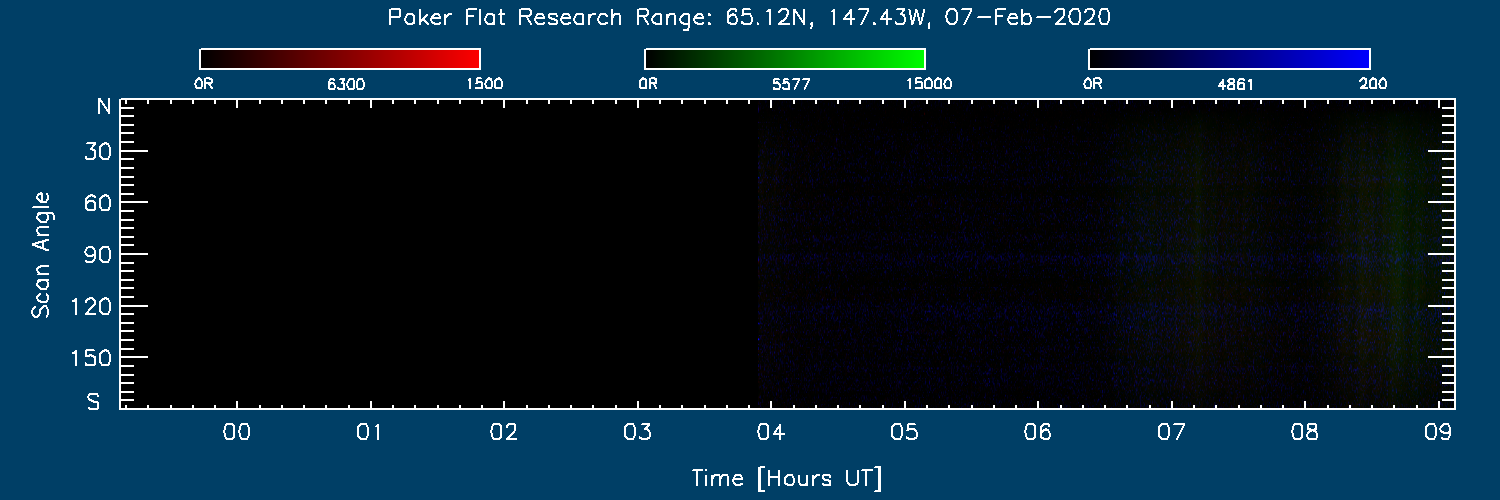Data Pages:
Real Time Thermospheric Weather Summary
Real-Time Data From Individual SDI Instruments
Real-Time Data from the Complete Alaskan SDI Network
Scanning Doppler Imager Monthly Data Browser
SDI Observing Log - Daily Pages
SDI Observing Log - Monthly Summaries
Useful External Links:
Real-Time Poker Optical Data
Latest Poker MSP Data
Real-Time PFISR Monitor (inside firewall only)
Latest 2-Hour PFISR Electron Densities (outside firewall)
PFISR Data Archive
Latest Condegrams
Aerospace Corp's Alaskan Photometers
Space Weather:
spacewx.com,
ACE,
SWPC
Condegrams:
Bz,
Vsw,
Den,
Poker Mag-H
Nat. WX Service:
PKR,
TLK,
KAK
WX Underground:
PKR,
TLK,
KAK,
MCM,
SPO
SDI Project Photos:
Announcements:
October 31, 2025
We have just upgraded the fore-optics for the instruments at Poker Flat and Eagle to our new 3D-printed setup. Both sites are working nicely. Poker is also using a new and simplified tripod to mount the instrument. Also, we are currently returning the SDI instruments for Scandinavia back to Alaska, due to EU import permits expiring. We plan to return them and recommission them within a few weeks - this time with permanent import licenses.
September 15, 2017
This server has had a difficult six months or so. We bought fancy and expensive RAID boxes configured to operate as NAS devices, which we were using as the primary working drives for data storage and analysis. Turns out that even expensive NAS devices don't work very well - in this case the network drives would appear and disappear from the net on timescales of seconds and minutes. Unsurprisingly, this caused chaos with our data handling and processing. So we finally gave in and bought a convenional and cheaper (~10% of the RAID cost) 8 Tb internal disk. Curiously, spending far less money produces a much better result; the internal disk works great! (As of now, at least...) So, for now, things are running far better.
April 23, 2016:
Many (but not all) of our routine data products are now working on the new data server. Points of note in the current status are that:
- Daily transfers from Antarctica are still not working automatically, in part due to link quality issues. Getting daily data back for post-processing currently requires manual intervention. This means that there will usually be gaps and latency in the results available through the "monthly data browser". Real-time status and data snapshots mostly do work automatically when the link is good.
- We are experiencing (previously unseen) problems with serial communications between the control computers to various motors in the instrument. We are working on this but, for now, there will likely data gaps due to the instruments getting "stuck" trying to communicate with their motors.
- ASCII files from South Pole currently contain incorrect lon and lat info for the observing locations. This is because our code to map sky look angles to geographic locations doesn't work for the weird location of South Pole. The error should be straightforward to correct, but it will take a few days to implement the fix.
April 11, 2016:
We finally have our new Antarctic sites at McMurdo and South Pole on the air and observing! Actually McMurdo has been working nicely for a couple of weeks now, whereas it's only just become dark enough at South Pole. There is a filter wheel issue at South Pole that means that for now we're devoting all our observing time there to the 630 nm emission. (At McMurdo we're alternating between 630 nm and 558 nm observations.)
April 11, 2016:
We are switching over to a newer, faster, and more capable server machine. The switch-over is not simple, and we do not yet have all the old functionality running on the new machine. (Because of changes in operating systems, a few minor features may never be restored.) However the new platform should enable far more reliable data archiving, and enough performance to allow us to develop some exciting new data products in coming months. Please stay tuned.
February 25, 2016:
The data link from Kaktovik has failed. Indications are that it is a wide-ranging problem with the Hughes Net link that the University uses there, and a short-term fix is not likely. The instrument can in principle run unattended without the link, but for now we have no way to restart operation if the system encounters an issue that needs operator intervention.
February 10, 2016:
Many bugs have been fixed in recent days, and a few new features added. Instrumental offsets in wind fields should now be correct in real-time data, and also in archived data from here onward. We will slowly work to correct the older archive data as well. The user interface has been updated to expose options for viewing data from McMurdo and South Pole, although we do not expect to actually begin acquiring these data until it gets dark in Antarctica in early April.
January 08, 2016:
We are currently gradually restoring functionality to the SDI network, after a rather lean year in 2015, during which a number of failures piled up on us. We are also just now setting up two new SDI sites in Antarctica. These are at Arrival Heights (McMurdo) and at South Pole. The South Pole site is actually using the SDI instrument that was at Mawson until the end of 2014. There is more to be done to get everything working properly, both in Antarctica and in Alaska, but we're hopeful 2016 will be an exciting year. Watch this space!
November 15, 2013:
We have problems at several sites. Poker is currently offline following power failures due to wind/ice storms in Fairbanks. HAARP remains offline because the site itself is not fully functioning at this time. Toolik is giving trouble with its cal/sky switching mechanism, and with its filter wheel. And, finally, Mawson is shut down for the southern summer. We are doing all we can get these instruments back on line for the forthcoming PINOT campaign.
September 14, 2013:
Toolik Lake is now running, after Carl and Manbharat made a trip up there to repair a fault in the sky/calibration view switch mechanism. Poker is also running, although there have been some problems with the camera during the last week or two that have produced erroneous wind fields. I tweaked some camera settings last night, which seems to have helped. However I will watch it over the next few days, as I am not yet convinced that the artifacts are completely gone. HAARP remains offline, because the whole site is off-contract and everything there is inaccessible. The hope is that it will be back and running within a few weeks.
April 20, 2013:
Actually, the filter wheel at HAARP failed again shortly after the previous fix. We're back to red-only operation there.
March 11, 2013:
Callum visited the HAARP instrument over March 1 & 2, with the result that it is once again observing at both 5577 and 6300 angstroms. Also, we have modified the monthly data browser so that SDI plots are now displayed on a page with various navigation buttons at the top, including ones for changing the wavelength, site, and day shown. These make it easier to work quickly through an extended period of days, browsing all plots of a given type. Log entries for cloud and SDI performance are also diplayed, if available.
Feb 21, 2013:
The Mawson instrument has begun observations for the 2013 austral winter. Firewall issues are currrently preventing us from receiving data in real-time, but post-processed data are freely available (with a latency of around 2 days) at http://sdi_server.gi.alaska.edu/sdi_web_plots/sdi_arc.asp?site=Mawson
Feb 21, 2013:
Check out the new movie showing SDI and other data from the night of the VISIONS rocket launch, at
http://sdi_server.gi.alaska.edu/sdiweb/Documents/Movies/SDI_VISIONS_Wind_Maps_DOY038_2013_(Feb_07)_with_superdarn.mov
Jan 09, 2013:
Poker 630 nm data from before 2003 have been re-analyzed and are available at http://sdi_server.gi.alaska.edu/sdi_web_plots/sdi_arc.asp. Green-line data from 2002-2005 have also been re-analyzed and are online at the same URL, although we have not yet corected the winds for instrumental offsets. Data from 2007-2012 are currently being re-analyzed, but this will still take some time. In the meantime, the old monthly data browser is still available for browsing data from before October 2102.
November 22, 2012:
Here is a simple IDL routine that should allow you to easily read ASCII data files downloaded from the monthly data browser page, using the IDL programming language.
About:
Instrument Photos
People: Mark Conde, Callum Anderson
Search SDI Documents:
|
|
Latest Data:





(Click the images to open them in a new tab.)
|




